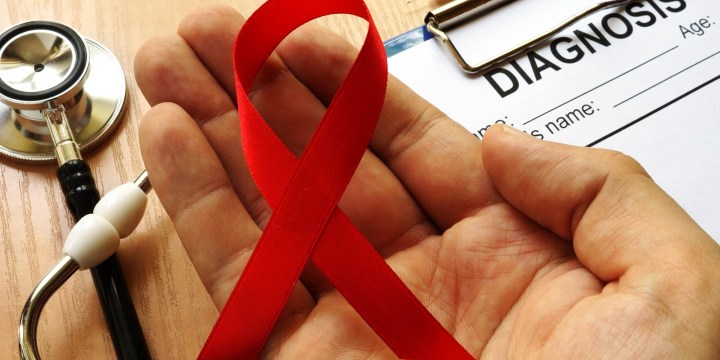MAVERICK CITIZEN OP-ED
Just give the ARVs: How red tape stifles efforts to control HIV

The fuss around transfer letters is emblematic of a healthcare system that still creates unnecessary barriers to accessing HIV care. If we hope to get the HIV epidemic under control, we need a patient-centred approach.
“I was stuck in the Eastern Cape and the nurses wouldn’t give me ARVs without a transfer letter.”
I am an HIV doctor. My patients move. They move to the Eastern Cape. They move back to Cape Town. Then they move to other parts of Cape Town. At every visit, we warn patients that if they plan to travel, they should come to the clinic to collect extra ARVs to tide them over or request a transfer letter, detailing their past medical history so that the next clinician knows their story. But let’s be honest, that’s not always possible. Sometimes they are forced to relocate suddenly because of a crisis. Other times they must travel for family emergencies at short notice, but then don’t have the money to get back.
Stuck away from home, people run out of ARVs, no transfer letter in hand. Some remain without medication because they don’t want to be scolded by a nurse or are unsure where to go. Yet many patients responsibly brave the local clinic to request extra medication. Some clinic nurses are helpful and give emergency supplies of ARVs. A sizeable group of patients, however, are turned away without medication, told to return with a transfer letter. But who is going to go back to Cape Town just for a transfer letter if they don’t have money to travel in the first place?
I hear this over and over again: “I stopped taking my ARVs because the nurses told me I needed a transfer letter.” I too love transfer letters. They have plenty of good information that clinicians need to make the best medical decisions for a patient’s care. But imperfect care is better than no care. Can you guess what medicine they were on? Usually. Can you phone the clinic they came from? Sometimes. Should a transfer letter be a barrier to care? Absolutely not.
The fuss around transfer letters is emblematic of a healthcare system that still creates unnecessary barriers to accessing HIV care. If we hope to get the HIV epidemic under control, we need a patient-centred approach. Discouraging patients is counterproductive and the costs immense. As we roll out a new HIV drug, Dolutegravir, we cannot afford to have an unwelcoming healthcare system that continues to sabotage our own patient’s care by placing obstacles in their way.
There are three problems with HIV patients interrupting care. Firstly, it is bad for the individual. Shortly after stopping ARVs, a patient’s viral load (the amount of HIV virus in their blood) quickly rebounds and their CD4 cell count drops, weakening their immune system and making them more prone to infection. Furthermore, when the patient restarts the medication, it may not work. Unlike with most other chronic diseases, poor adherence can lead to drug resistance. If a hypertensive patient skips medication, it is not good for the individual’s health, but the medication will still work when it is restarted.
If an HIV patient skips medication, the virus gains time and opportunity to replicate and mutate. Eventually, the virus will develop specific mutations that confer drug resistance. Resistance means that the drug can no longer disable the virus; in simple terms, it stops working. HIV drug resistance eventually leads to treatment failure and unchecked HIV.
The final problem with HIV patients interrupting care is that they can spread the virus to other people. HIV treatment is not only good for the individual but is essential for prevention. HIV-positive patients who are taking their ARVs religiously and have an undetectable viral load – meaning they have no detectable virus in their blood – cannot spread HIV to uninfected people.
Treatment is key to controlling the HIV epidemic in South Africa, because it keeps individuals healthy and prevents new cases. Because of this, the WHO and South Africa have endorsed the 90-90-90 strategy. The goal is for 90% of the 7.7 million South Africans living with HIV to know their status, 90% of those diagnosed positive to get on treatment, and 90% of those on treatment to have suppressed viral loads.
Despite huge gains, in 2018 South Africa still had approximately 240,000 new infections and 71,000 AIDS-related deaths. Only 54% of people living with HIV were both on treatment and virally suppressed, indicating their treatment was working (South Africa).
In order to push towards stopping HIV, South Africa has just rolled out a new ARV: Dolutegravir. The backbone of the old first-line regimen ARV was Efavirenz. Efavirenz is a good drug, but it has several unpleasant side effects and a “low barrier” to resistance. One mutation and it essentially stops working. In fact, 10-15% of South Africans newly infected with HIV are likely to already have Efavirenz resistance, because they were unlucky enough to get HIV from someone who had developed resistance to the virus.
If and when Efavirenz stopped working, people were forced to switch to alternative drugs that required six pills per day with even nastier side effects. Dolutegravir is great because it has very few side effects and a high barrier to resistance. Essentially it is one pill a day that is easy to take and more forgiving of imperfect usage. This ought to increase adherence, making patients more likely to be viral suppressed, and less likely to transmit the virus to new people. Boom. Less HIV.
But a pill is only great if a patient has access to it. Although Dolutegravir has a high barrier to resistance, it is not impossible to break. And I have no doubt that the South African system will try. For Dolutegravir to be successful, the South African medical system must do its best to help patients stay on their ARVs.
My patients live complicated and mobile lives in which struggling to survive often takes precedence over remaining on treatment. Clinicians must empathise with these very real struggles and help patients whenever we can. We need patient-centred, friendly care that encourages adherence, rather than penalises poverty. If a patient attempts to go to a new clinic for ARVs, they should be congratulated for their responsibility, rather than shouted at for not producing the proper documentation. If a patient returns to treatment, they should be welcomed back into care rather than scolded for the interruption.
If a patient needs to work or travel, they should be given multiple months’ worth of medication to decrease the burden of lengthy clinic visits. Community-based interventions, such as delivering ARVs through adherence clubs or medication “ATMs,” should be expanded to make it even easier to collect ARVs at convenient times and locations. Finally, hospital administrators must hold their clinicians accountable and train staff on empathic engagement skills.
The system also needs to be smarter and use technology to improve coordination of care rather than relying on antiquated transfer letters. The Western Cape is working on a “single patient viewer” in which a clinician can log into a website and access the patient’s pooled medical records, including their drug, laboratory and visit data from anywhere in the Western Cape.
This sort of electronic medical record will provide much of the information needed to ensure that a patient continues the correct treatment, without solely relying on the patient to hand-carry the paper trail. Given that patients travel between provinces, expanding a similar electronic medical record to the entire country is essential to coordinating care between clinics and decreasing barriers to adherence.
With Dolutegravir, South Africa has a great opportunity to meet its 90-90-90 targets and eliminate HIV. We cannot sabotage our efforts with bad habits. People living with HIV must do their part: get tested, get treatment, and stay on that treatment for the rest of their lives. However, the healthcare system must make it as easy as possible for people to remain in care by giving more ARVs at one time – preferably at convenient community pickup points whenever possible in order to avoid long clinic queues – and by using technology to better coordinate care between hospitals.
Finally, as healthcare providers, we doctors and nurses must do our part too: empathise that taking life-long treatment is hard, especially in the context of poverty, smile, and whenever we can:
JUST GIVE THE DAMN ARVs. DM
Andrea Mendelsohn is an American Family Physician. She received her medical and public health degree from Tufts University School of Medicine in Boston. She has worked in primary healthcare and public health in underserved communities in the US, Ethiopia, India, Ghana, & South Africa. She has been working as a senior medical officer in a HIV/TB primary healthcare clinic in Cape Town since 2017.


















 Become an Insider
Become an Insider